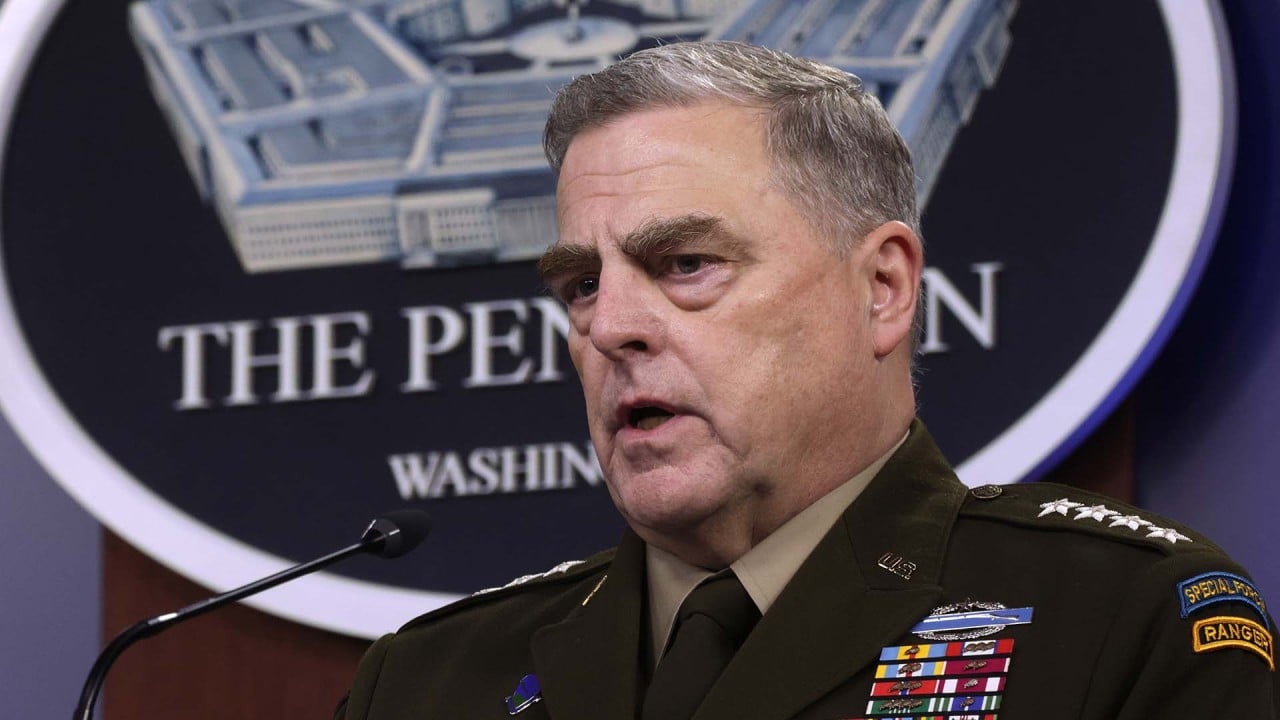
US defence establishment alert to ‘stunning’ Chinese military advances
- Shift in the global balance of power is seen as complicating Washington’s alliances in Asia
- China’s test of hypersonic weapon able to partially orbit Earth then find a target was close to a Sputnik moment, says Joint Chiefs of Staff head Mark Milley
“The pace at which China is moving is stunning,” said General John Hyten, the No 2-ranking US military officer, who previously commanded US nuclear forces and oversaw Air Force space operations.
At stake is a potential shift in the global balance of power that has favoured the United States for decades. A realignment more favourable to China does not pose a direct threat to the United States but could complicate US alliances in Asia. New signs of how the Pentagon intends to deal with the China challenge may emerge in the coming weeks from Biden administration policy reviews on nuclear weapons, global troop basing and overall defence strategy.
For now, officials marvel at how Beijing is marshalling the resources, technology and political will to make rapid gains – so rapid that the Biden administration is attempting to reorient all aspects of US foreign and defence policy.

02:06
Chinese hypersonic weapons test ‘has all of our attention’, US General Mark Milley says
General Mark Milley, chairman of the Joint Chiefs of Staff, said the test was “very close” to being a Sputnik moment, akin to the 1957 launching by the Soviet Union of the world’s first space satellite, which caught the world by surprise and fed fears that the United States had fallen behind technologically. What followed was a nuclear arms and space race that ultimately bankrupted the Soviet Union.
Milley and other US officials have declined to discuss details of the Chinese test, saying they were secret. He called it “very concerning” for the United States but added that problems posed by China’s military modernisation ran far deeper.
“That’s just one weapon system,” he said in a Bloomberg Television interview. “The Chinese military capabilities are much greater than that. They’re expanding rapidly in space, in cyber and then in the traditional domains of land, sea and air.”
On the nuclear front, private satellite imagery in recent months has revealed large additions of launch silos that suggest the possibility that China plans to increase its fleet of land-based intercontinental ballistic missiles, or ICBMs.
Hans Kristensen, a nuclear weapons expert at the Federation of American Scientists, said China appeared to have about 250 ICBM silos under construction, which he said was more than 10 times the number in operation today. The US military, by comparison, had 400 active ICBM silos and 50 in reserve.
Pentagon officials and defence hawks on Capitol Hill point to China’s modernisation as a key justification for rebuilding the US nuclear arsenal, a project expected to cost more than US$1 billion over 30 years, including sustainment costs.
Fiona Cunningham, an assistant professor of political science at the University of Pennsylvania and a specialist in Chinese military strategy, said a key driver of Beijing’s nuclear push was its concerns about US intentions.
“I don’t think China’s nuclear modernisation is giving it a capability to pre-emptively strike the US nuclear arsenal, and that was a really important generator of competition during the Cold War,” Cunningham said in an online forum sponsored by Georgetown University. “But what it does do is to limit the effectiveness of US attempts to pre-emptively strike the Chinese arsenal.”
Some analysts fear Washington will worry its way into an arms race with Beijing, frustrated at being unable to draw the Chinese into security talks. Congress also is increasingly focused on China and supports a spending boost for space and cyber operations and hypersonic technologies. There is a push, for example, to put money in the next defence budget to arm guided-missile submarines with hypersonic weapons, a plan initiated by the Trump administration.
For decades, the United States tracked China’s increased defence investment and worried that Beijing was aiming to become a global power. But for at least the last 20 years, Washington was focused more on countering al-Qaeda and other terrorist threats in Iraq and Afghanistan. That began to change during the Trump administration, which in 2018 formally elevated China to the top of the list of defence priorities, along with Russia, replacing terrorism as the No 1 threat.
US vs China: who has the stronger military?
For now, Russia remains a bigger strategic threat to the United States because its nuclear arsenal far outnumbers China’s. But Milley and others say Beijing is a bigger long-term worry because its economic strength far exceeds that of Russia, and it is rapidly pouring resources into military modernisation.
At the current pace of China’s military investment and achievement, Beijing “will surpass Russia and the United States” in overall military power in the coming years “if we don’t do something to change it”, said Hyten, who is retiring in November after two years as vice-chairman of the Joint Chiefs of Staff. “It will happen.”
The Biden administration has said it is determined to compete effectively with China, banking on a network of allies in Asia and beyond that are a potential source of strength that Beijing cannot match.
Taiwan is another big worry. Senior US military officers have been warning this year that China was probably accelerating its timetable for capturing control of Taiwan, the island democracy widely seen as the most likely trigger for a potentially catastrophic US-China war.
“We have a commitment to do that,” Biden said. The White House later said he was not changing US policy, which does not support Taiwanese independence but is committed to providing defensive arms.

